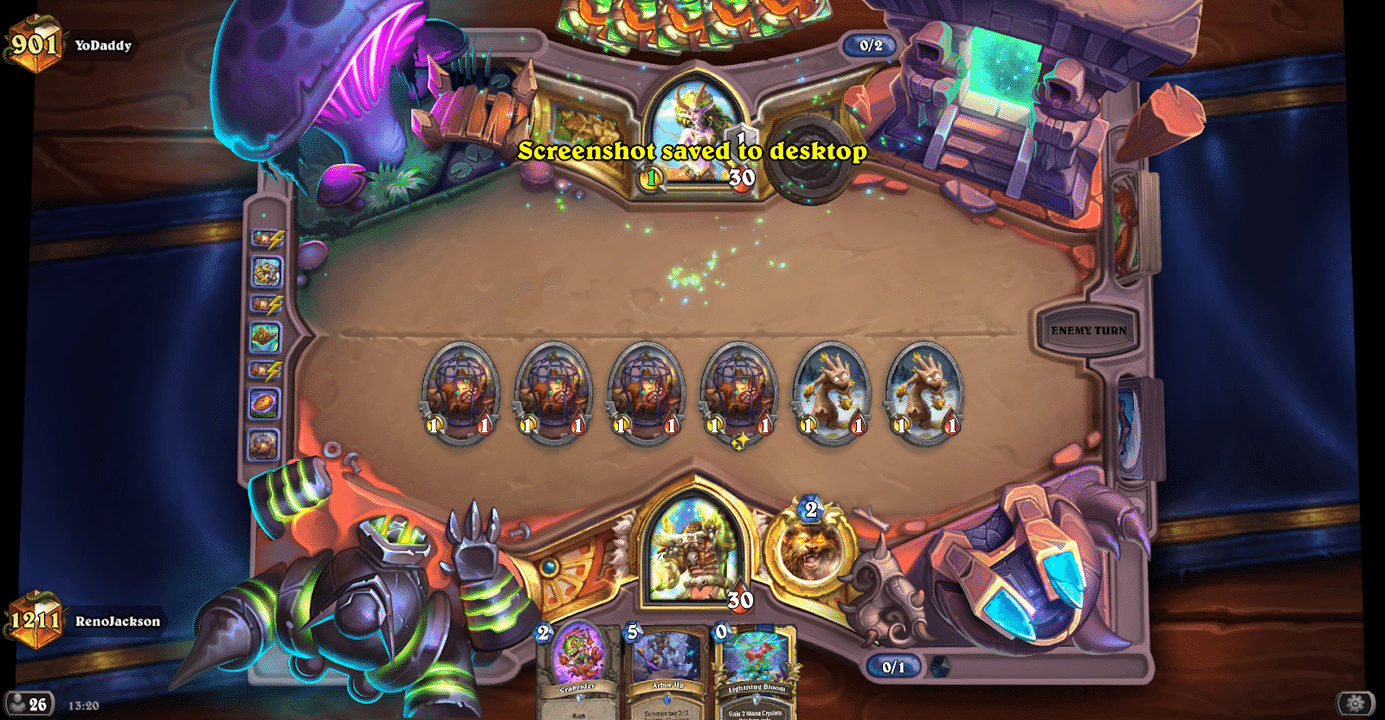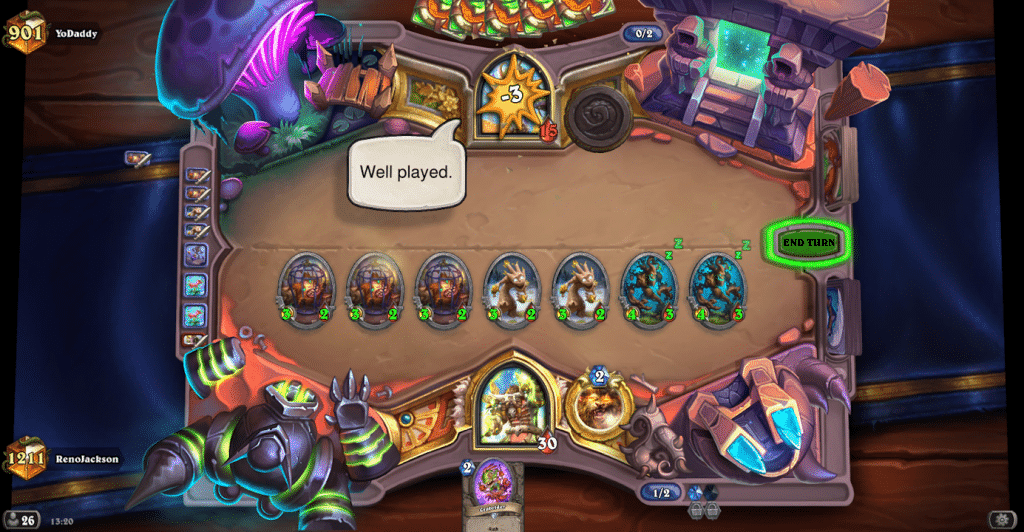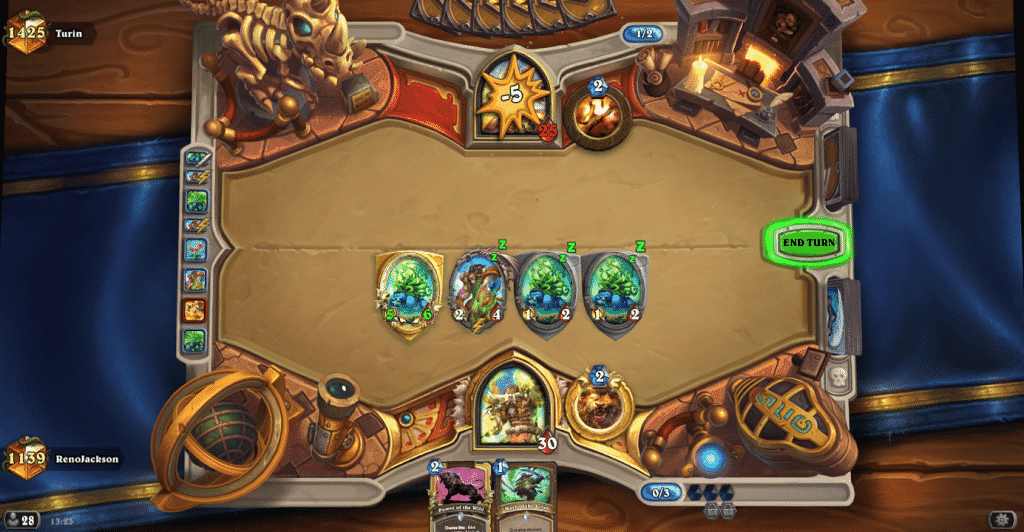- May 9, 2021
- By neon31
- In Articles, Guest Post
- No Comment
- 0
Hearthstone Wild Token Druid Deck List & Guide | By RenoJacksonHS

Token Druid has always been that awkward third-wheel when it comes to deck options within the class. Slow Control Druids have always been favored in the meta regardless of performance, while hyper-aggro Druids are almost always picked over Token Druid for the general playerbase. Despite being overlooked, Token Druid is actually a very decent archetype taken to high legend by several players, and is arguably a better choice than Aggro Druid after the nerf to Voracious Reader. While it might not be as good as Celestial Alignment Druids in the current expansion, it offers valid counterplays to the very strategy. I played the deck from Diamond 5 to Legend, and continued to play it from Rank 1400 until I hit Top 600.
This article will go into details about how the deck operates and how to play it optimally.

Table of Contents
Table of Contents
The Token Druid core
These are the most important cards for my iteration of Token Druid, and should not be replaced if possible. This is why I’ve chosen these cards:
» Gibberling
The most important minion in this deck. It functions as an early game board swarm, and can create the most absurd early boards that can win on the spot. Great to couple up with early game spells like Lightning Bloom and Living Roots.
This is how an opening with Gibberling might look like:

» Lightning Bloom
Our ultimate early game mana cheat. It plays a crucial part in cloning multiple Gibberlings in the early game, buffing a Crabrider quickly, cheating out Arbor Ups, etc. However, the most interesting use case of this card is in conjunction with the new Druid legendary, Guff Runetotem. Since Bloom is a Nature spell, Guff can immediately give another minion +2/+2, and Bloom gives you even more mana to buff a target that can go face right away. All in all, a very important card in a faster Token Druid build.
This is how an opening with Gibberling and Lightning Bloom might look like:

How Lightning Bloom propels a Guff early game:

» Mark of the Lotus, Power of the Wild, Arbor Up
The glue that holds the deck together. It would be impossible to build a viable fast Druid deck in the current climate without these efficient board buffs.
» Savage Roar
A reliable finisher that offers the most damage output in a single turn. A long-standing Token Druid staple.
» Living Roots, Adorable Infestation
The most efficient options other than Gibberling to create wide and early boards.
» Guff Runetotem
Unlike other board buffs, Runetotem is a single-target buff. However, it’s so effective in what it does and it synergizes very well with a great number of Nature spells. Therefore, it deserves a spot in this list.
» Solar Eclipse
A flexible card that can be used to double-up the effect of board buffs and board fills.
» Fungal Fortunes
The only refill in this deck, and the only one efficient enough to be considered playing. It very often hits 3 cards in this deck, which makes it worth it.
Cards I’ve omitted
» Speaker Gidra
At 2-mana, Crabrider is an efficient minion. Speaker Gidra is 3 mana, which makes it a tad expensive, and you can’t efficiently reap the benefit from its effect also.
» Wispering Woods & Glowfly Swarm
These 2 cards are really good in a slower Token Druid version; however, this deck unloads its hand way too fast for them to make sense. Same goes with Spreading Plague, which is too slow and sits on your hand way too often.
» Branching Paths
A worse Savage Roar which is 1 mana more expensive. And let’s be honest, if you have to use Paths to draw, you have more often than not lost the game.
» Blessing of the Ancient
Also a bit slow, but is probably more viable than Paths. I’d consider a copy of this over Nature Studies.
General strategy
» General Aggro
Mulligan: Acornbearer, Living Roots, Gibberling, Crabrider, Adorable Infestation (if you have Gibberling or other 1-drops), Lightning Bloom (if you have a 1-drop), Mark of the Lotus (if you have 1-drop), Power of the Wild (if you have 1 drops and Lightning Bloom).
The gameplan versus other board-based Aggro decks is to establish a board before they do. This is done by Gibberling shenanigans, Crabriders, and general 1-drops into board buffs. Remember to make favorable trades into their tokens unless you have clear 2 turn lethal from hand and there’s nothing that comes to mind from the opponent to ruin your board or counter-lethal you.
There are plenty of 1 HP minions in the game right now, like Odd Paladin recruits or Rogue and Warrior Pirates etc. and Crabrider can be used to trade them away cleanly. Crabrider can also be played alongside Adorable Infestation and Mark of the Wild for a trade up while protecting your board.
» Kingsbane Rogue
Mulligan: Acornbearer, Gibberling, Living Roots, Crabrider, Adorable Infestation (if you have Gibberling or other 1-drops), Lightning Bloom (if you have a 1-drop), Mark of the Lotus (if you have 1-drop), Thorngrowth Sentries, Mark of the Wild (if you have a 1-drop).
Against Kingsbane Rogue, you need to make a big board as soon as possible so that their Dread Corsairs aren’t threatening when dropped, or their 2/1 Pirate won’t be able to one shot your Crabrider. Keeping Thorngrowth Sentries is decent too for blocking a couple Kingsbane hits.
» Control Reno decks
Mulligan: Acornbearer, Gibberling, Living Roots, Crabrider, Adorable Infestation (if you have Gibberling or other 1-drops), Lightning Bloom (if you have a 1-drop), Mark of the Lotus (if you have 1-drop), Savage Roar (if you have lots of 1-drops), Arbor Up (if you have Lightning Bloom).
These are tough matchups. You often think you might need to play around key board clears like Defile, Breath of the Infinite, etc. However, some of them might not be possible to play around (like Dark Skies). You need to think about whether playing around key board clears is worth it: does your opponent keep cards in mulligan? Is he expecting slow Druid or fast Druid? See if you have 2-turn lethal. If you do, it’s often worth the risk to go all in.
» Flamewaker Mage
Mulligan: Acornbearer, Gibberling, Living Roots, Crabrider, Adorable Infestation (if you have Gibberling or other 1-drops), Lightning Bloom (if you have a 1-drop), Mark of the Lotus (if you have 1-drop), Savage Roar (if you have lots of 1-drops), Arbor Up (if you have Lightning Bloom).
This is a favorable matchup. You need to put them in a position where they have to play a premature Flamewaker to fight off the pressure; however, you have the upper hand since this deck can generate pressure very early and very efficiently. Try to make the widest board possible within the first 2 turns then buff them up so the Flamewaker can’t clear them all. ALWAYS remove their Flamewaker. You can save a Crabrider on hand for the Flamewaker if need be. Flamewaker is their main win condition, and they’ll have to dig into their random spell pool or draw symmetrically which gives you more resources. No Flamewaker means you’re free to develop your board again, while they have nothing but burn spells.
» Celestial Druid
Mulligan: Acornbearer, Gibberling, Living Roots, Crabrider, Adorable Infestation (if you have Gibberling or other 1-drops), Lightning Bloom (if you have a 1-drop), Mark of the Lotus, Power of the Wild (if you have 1-drop), Savage Roar (if you have lots of 1-drops), Arbor Up.
This matchup isn’t hard since they give you mana with Biology Project. This is why you keep Arbor Up so you can capitalize on the free mana and make a huge board to pressure them. As long as you threaten lethal before their Turn 7, you should be fine.
» Even Shaman, Darkglare Warlock & Handbuff Paladin
Mulligan: Acornbearer, Gibberling, Living Roots, Crabrider, Adorable Infestation (if you have Gibberling or other 1-drops), Lightning Bloom (if you have a 1-drop), Mark of the Lotus (if you have 1-drop), Arbor Up (if you have Lightning Bloom) (do not keep Arbor Up vs Darkglare)
Even Shaman is not a popular matchup, but one I think I should share the strategy nonetheless. This matchup is extremely hard for the Druid if you don’t know what you’re doing. You should only trade away the totems in the first 2 turns. Then GO FACE! You will never be able to trade away all the efficient totems they create, and the more you delay, the more you play into Devolve, Thing from Below, and Sea Giant. Same goes for Handbuff and Darkglare Warlock. Their minions will soon become too big to overcome, so you should just kill them before they can get it rolling.
This Guide was written by RenoJackson – You can check him out on Twitter!
Do you want to have your work featured on Hearthstone-Decks.net? Email us at neon31HS@gmail.com, and we’ll talk! Also, feel free to join our Discord, or follow us on Twitter or Facebook. You can also support us on Patreon!
You might also be interested in...
- Phone vs Tablet: Which Should You Use for Gambling in Online Casinos? November 24, 2025
Submit your Top 500 Legend Build, be seen by thousands of people!
